Abstract
The influenza A/Ann Arbor/6/60 (H2N2) cold-adapted (ca) virus was evaluated as a donor of attenuating genes to new variants of influenza A virus. This ca donor virus was mated with the A/Alaska/6/77 (H3N2) wild-type virus, and three A/Alaska/6/77 (H3N2) ca recombinant viruses were produced. The parental origin of the genes in the three ca recombinants had been determined previously (2), and their virulence for adult seronegative volunteers was assessed in the present study to identify the genes present in the ca donor virus that confer attenuation. Each of the recombinants received the hemagglutinin and neuraminidase genes from the A/Alaska/6/77 (H3N2) wild-type parent. One ca recombinant (CR-29) received all six transferable genes from the ca parent and was found to be satisfactorily attenuated in the volunteers. The two other ca recombinants received five of the six transferable genes with a wild-type gene at the M or NS locus. The pattern of infection in humans with these latter two ca recombinants was similar to the CR-29 ca recombinant. These findings demonstrate that inheritance of a gene in ca recombinants at the M or NS locus segregates independently of attenuation and suggest that the M and NS genes present in the ca donor virus are not the major determinants of attenuation conferred by this virus.
Full text
PDF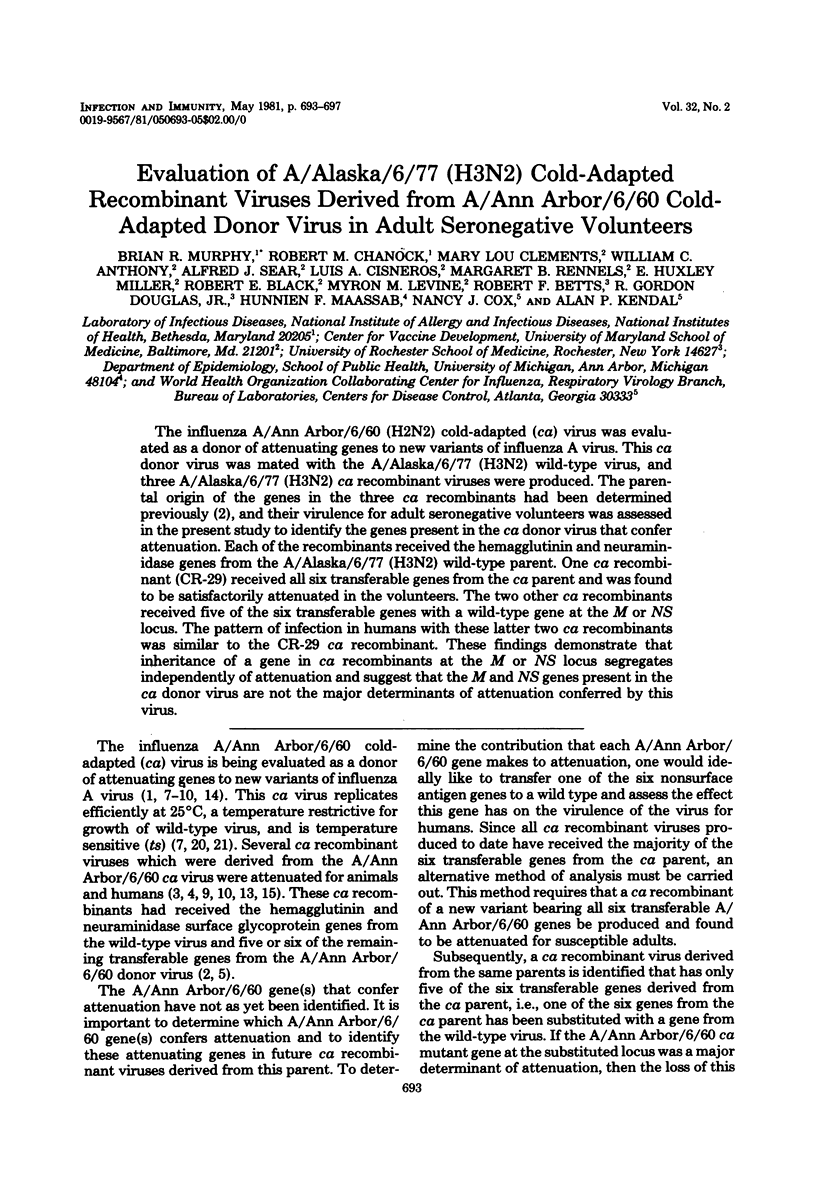
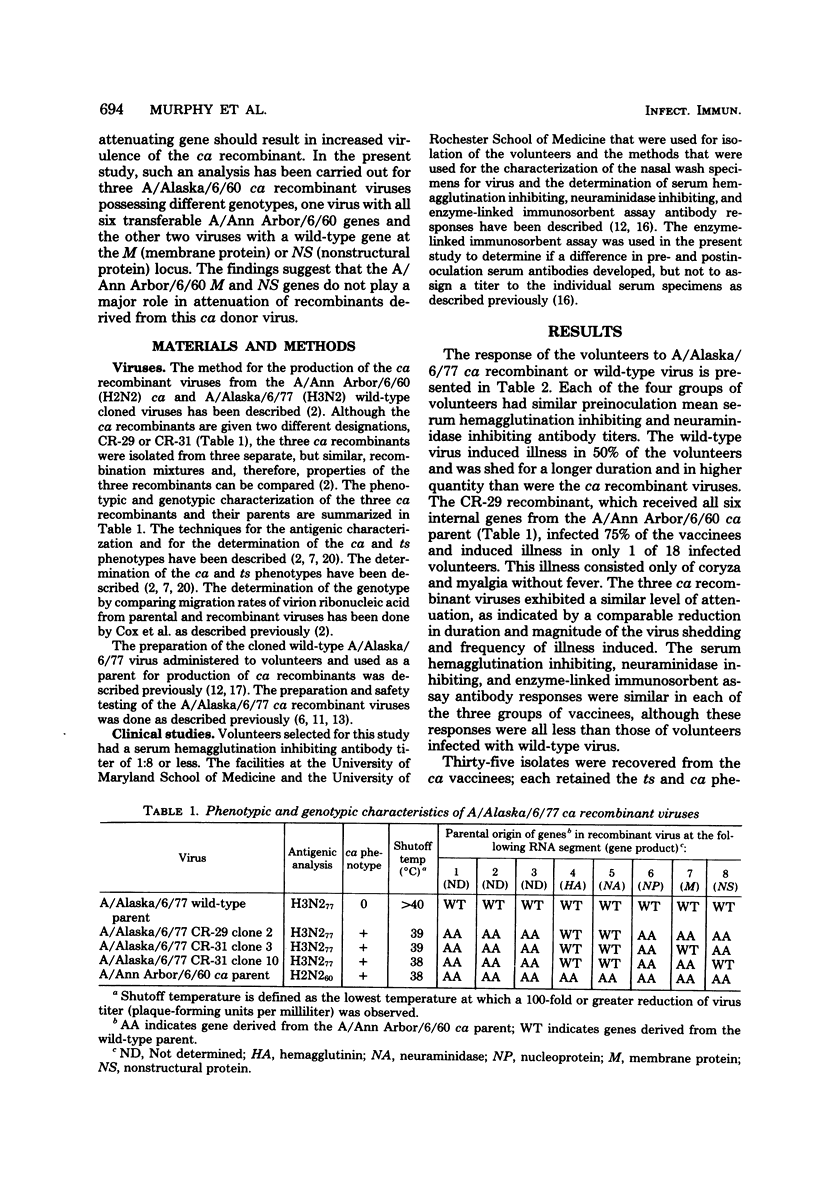
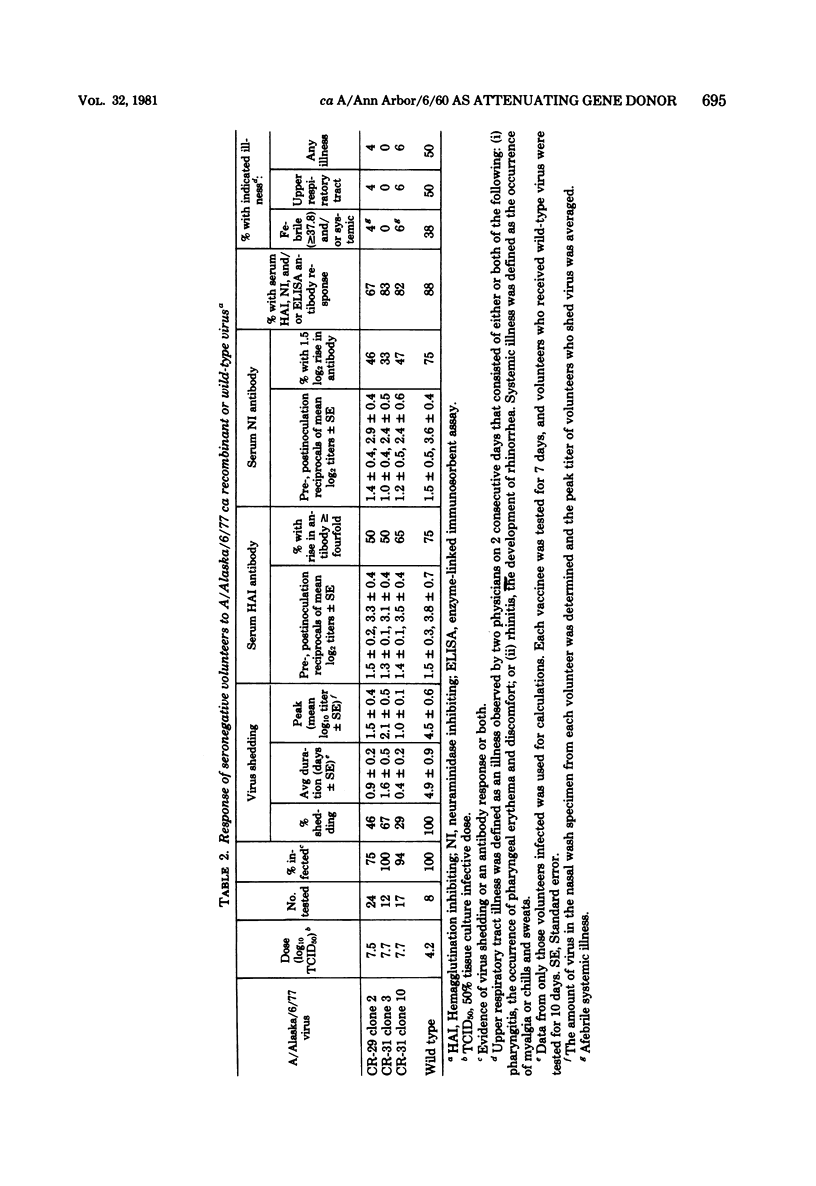
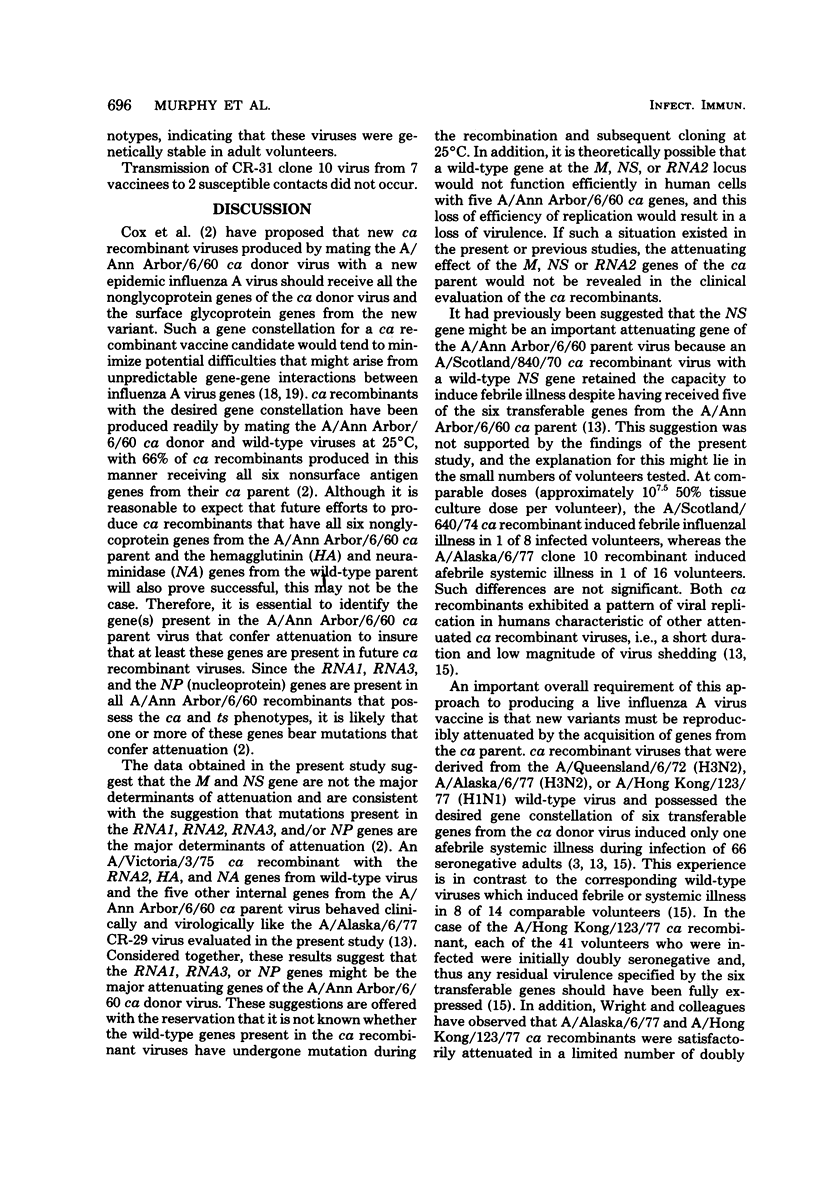
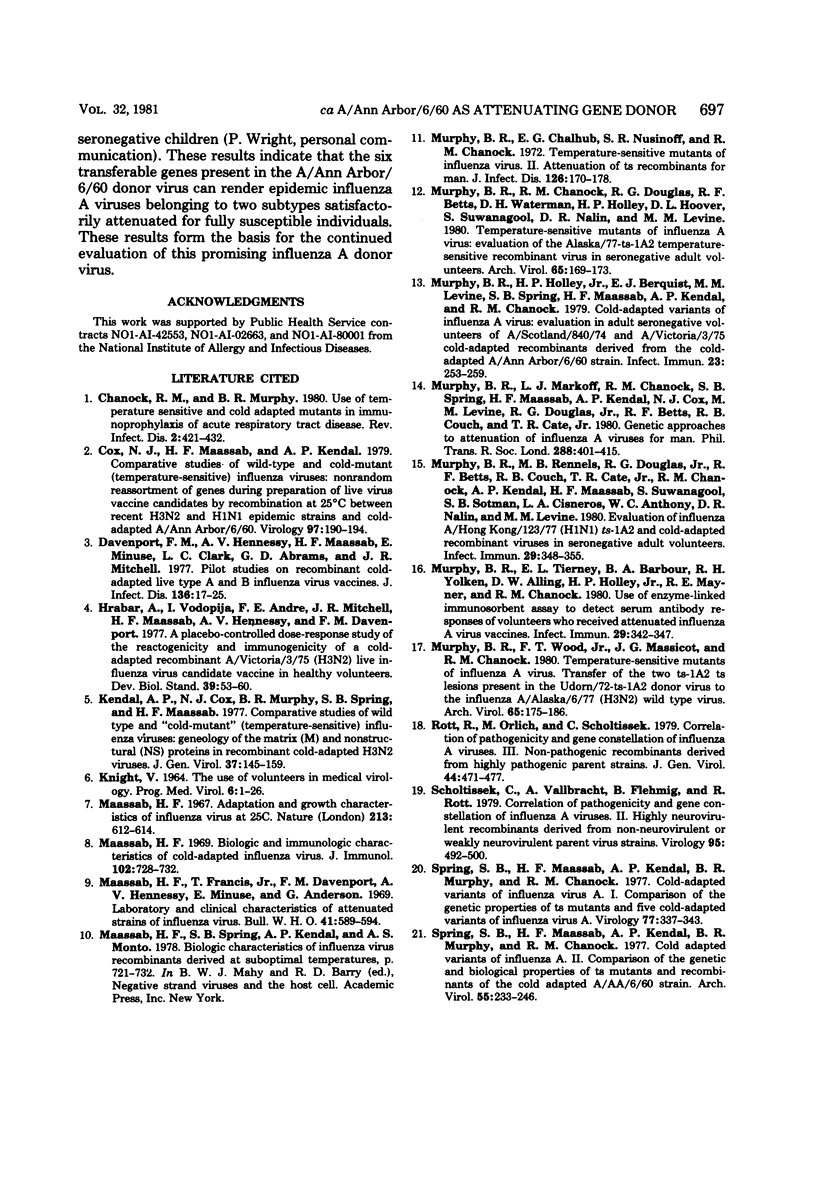
Selected References
These references are in PubMed. This may not be the complete list of references from this article.
- Chanock R. M., Murphy B. R. Use of temperature-sensitive and cold-adapted mutant viruses in immunoprophylaxis of acute respiratory tract disease. Rev Infect Dis. 1980 May-Jun;2(3):421–432. doi: 10.1093/clinids/2.3.421. [DOI] [PubMed] [Google Scholar]
- Cox N. J., Maassab H. F., Kendal A. P. Comparative studies of wild-type and cold-mutant (temperature-sensitive) influenza viruses: nonrandom reassortment of genes during preparation of live virus vaccine candidates by recombination at 25 degrees between recent H3N2 and H1N1 epidemic strains and cold-adapted A/An Arbor/6/60. Virology. 1979 Aug;97(1):190–194. doi: 10.1016/0042-6822(79)90386-6. [DOI] [PubMed] [Google Scholar]
- Davenport F. M., Hennessy A. V., Maassab H. F., Minuse E., Clark L. C., Abrams G. D., Mitchell J. R. Pilot studies on recombinant cold-adapted live type A and B influenza virus vaccines. J Infect Dis. 1977 Jul;136(1):17–25. doi: 10.1093/infdis/136.1.17. [DOI] [PubMed] [Google Scholar]
- Hrabar A., Vodopija I., André F. E., Mitchell J. R., Maassab H. F., Hennessy A. V., Davenport F. M. A placebo-controlled dose-response study of the reactogenicity and immunogenicity of a cold-adapted recombinant A/Victoria/3/75 (H3N2) live influenza virus candidate vaccine in healthy volunteers. Dev Biol Stand. 1977 Jun 1;39:53–60. [PubMed] [Google Scholar]
- KNIGHT V. THE USE OF VOLUNTEERS IN MEDICAL VIROLOGY. Prog Med Virol. 1964;6:1–26. [PubMed] [Google Scholar]
- Kendal A. P., Cox N. J., Murphy B. R., Spring S. B., Maassab H. F. Comparative studies of wild-type and 'cold-mutant' (temperature sensitive) influenza viruses: geneology of the matrix (M) and non-structural (NS) proteins in recombinant cold-adapted H3N2 viruses. J Gen Virol. 1977 Oct;37(1):145–159. doi: 10.1099/0022-1317-37-1-145. [DOI] [PubMed] [Google Scholar]
- Maassab H. F. Adaptation and growth characteristics of influenza virus at 25 degrees c. Nature. 1967 Feb 11;213(5076):612–614. doi: 10.1038/213612a0. [DOI] [PubMed] [Google Scholar]
- Maassab H. F. Biologic and immunologic characteristics of cold-adapted influenza virus. J Immunol. 1969 Mar;102(3):728–732. [PubMed] [Google Scholar]
- Maassab H. F., Francis T., Jr, Davenport F. M., Hennessy A. V., Minuse E., Anderson G. Laboratory and clinical characteristics of attenuated strains of influenza virus. Bull World Health Organ. 1969;41(3):589–594. [PMC free article] [PubMed] [Google Scholar]
- Murphy B. R., Chalhub E. G., Nusinoff S. R., Chanock R. M. Temperature-sensitive mutants of influenza virus. II. Attenuation of ts recombinants for man. J Infect Dis. 1972 Aug;126(2):170–178. doi: 10.1093/infdis/126.2.170. [DOI] [PubMed] [Google Scholar]
- Murphy B. R., Chanock R. M., Douglas R. G., Betts R. F., Waterman D. H., Holley H. P., Jr, Hoover D. L., Suwanagool S., Nalin D. R., Levine M. M. Temperature-sensitive mutants of influenza A virus: evaluation of the Alaska/77-ts-1A2 temperature-sensitive recombinant virus in seronegative adult volunteers. Arch Virol. 1980;65(2):169–173. doi: 10.1007/BF01317328. [DOI] [PubMed] [Google Scholar]
- Murphy B. R., Holley H. P., Jr, Berquist E. J., Levine M. M., Spring S. B., Maassab H. F., Kendal A. P., Chanock R. M. Cold-adapted variants of influenza A virus: evaluation in adult seronegative volunteers of A/Scotland/840/74 and A/Victoria/3/75 cold-adapted recombinants derived from the cold-adapted A/Ann Arbor/6/60 strain. Infect Immun. 1979 Feb;23(2):253–259. doi: 10.1128/iai.23.2.253-259.1979. [DOI] [PMC free article] [PubMed] [Google Scholar]
- Murphy B. R., Rennels M. B., Douglas R. G., Jr, Betts R. F., Couch R. B., Cate T. R., Jr, Chanock R. M., Kendal A. P., Maassab H. F., Suwanagool S. Evaluation of influenza A/Hong Kong/123/77 (H1N1) ts-1A2 and cold-adapted recombinant viruses in seronegative adult volunteers. Infect Immun. 1980 Aug;29(2):348–355. doi: 10.1128/iai.29.2.348-355.1980. [DOI] [PMC free article] [PubMed] [Google Scholar]
- Murphy B. R., Tierney E. L., Barbour B. A., Yolken R. H., Alling D. W., Holley H. P., Jr, Mayner R. E., Chanock R. M. Use of the enzyme-linked immunosorbent assay to detect serum antibody responses of volunteers who received attenuated influenza A virus vaccines. Infect Immun. 1980 Aug;29(2):342–347. doi: 10.1128/iai.29.2.342-347.1980. [DOI] [PMC free article] [PubMed] [Google Scholar]
- Murphy B. R., Wood F. T., Massicot J. G., Chanock R. M. Temperature-sensitive mutants of influenza A virus. Transfer of the two ts-1A2 ts lesions present in the Udorn/72-ts-1A2 donor virus to the influenza A/Alaska/6/77 (H3N2) wild type virus. Arch Virol. 1980;65(2):175–186. doi: 10.1007/BF01317329. [DOI] [PubMed] [Google Scholar]
- Rott R., Orlich M., Scholtissek C. Correlation of pathogenicity and gene constellation of influenza A viruses. III. Non-pathogenic recombinants derived from highly pathogenic parent strains. J Gen Virol. 1979 Aug;44(2):471–477. doi: 10.1099/0022-1317-44-2-471. [DOI] [PubMed] [Google Scholar]
- Scholtissek C., Vallbracht A., Flehmig B., Rott R. Correlation of pathogenicity and gene constellation of influenza A viruses. II. Highly neurovirulent recombinants derived from non-neurovirulent or weakly neurovirulent parent virus strains. Virology. 1979 Jun;95(2):492–500. doi: 10.1016/0042-6822(79)90503-8. [DOI] [PubMed] [Google Scholar]
- Spring S. B., Maassab H. F., Kendal A. P., Murphy B. R., Chanock R. M. Cold adapted variants of influenza A. II. Comparison of the genetic and biological properties of ts mutants and recombinants of the cold adapted A/AA/6/60 strain. Arch Virol. 1977;55(3):233–246. doi: 10.1007/BF01319909. [DOI] [PubMed] [Google Scholar]
- Spring S. B., Maassab H. F., Kendal A. P., Murphy B. R., Chanock R. M. Cold-adapted variants of influenza virus A. I. Comparison of the genetic properties of ts mutants and five cold-adapted variants of influenza virus A. Virology. 1977 Mar;77(1):337–343. doi: 10.1016/0042-6822(77)90430-5. [DOI] [PubMed] [Google Scholar]


